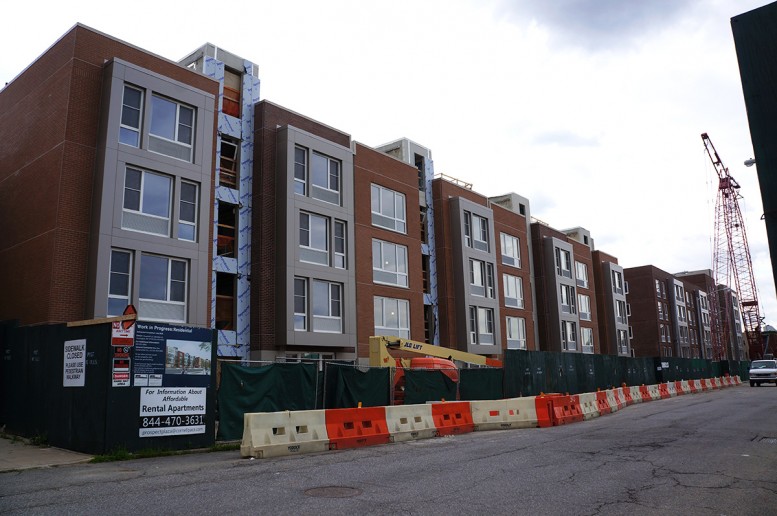As the city edges towards its 2020 population forecast, the Museum of the City of New York is delving into our decades-long struggle to shelter the poorest residents with a new exhibit on the history of affordable housing. To celebrate the exhibit’s opening, the museum hosted a panel Thursday night, where a collection of real estate executives debated whether de Blasio’s ambitious plan to build or preserve 200,000 units would make a dent in the city’s affordable housing crisis.
“At the moment, there are more [rent-regulated] units being lost or converted to market-rate than any [housing] program can meet,” said Saky Yakas, a partner at SLCE Architects. “And I haven’t heard any legislation to stop this bleeding from the inventory that exists.”
The other speakers pointed out that the mayor’s housing initiative aims to extend the regulatory agreements that keep certain kinds of subsidized units at below-market rates—like Mitchell-Lama, Section 8, and income-restricted rentals.
“It costs a building owner $500 or $600 a month to keep the lights and the heat on in a unit,” explained Rafael Cestero, president of the Community Preservation Corporation. “So if you make $20,000 a year as a family of four, you can’t even afford the basic cost of water, electric and heat. There is a fundamental challenge that we face as a city around the fundamental cost of operating and building property. This isn’t a philosophical debate.”
Cestero explained that we need better income-based rental subsidies to fill the gap and help keep building owners in the black. But as former Rep. Barney Frank noted during his keynote earlier in the evening, Congress has consistently cut funding for federal housing programs like Section 8, and the city and state have fewer resources to heavily subsidize rents.
But last year, Mayor de Blasio crafted a new rent voucher program called LINC, which gives formerly homeless families $1,200 to $1,900 a month to leave the shelter system. Ismene Speliotis, executive director of the Mutual Housing Association of New York, blamed landlords and developers for not accepting the vouchers. Thousands of families aren’t able to use them, possibly because landlords are worried LINC will meet the same fate as its predecessor, Advantage. The state gutted that subsidy program in 2011.
And one developer wondered whether the New York City could partner with nearby cities where land and construction costs are cheaper in order to build affordable housing for less. Former HPD Commissioner Richard Roberts, who now works for Red Stone Equity Partners, suggested Yonkers or Mount Vernon. Westchester and Long Island don’t carry their weight in terms of housing development, but the state could push for better zoning or tax abatements to encourage more construction in those counties.
Others highlighted the need for more market-rate development in the city’s cheapest neighborhoods—like eastern Queens, southern Brooklyn and the upper Bronx. The Department of City Planning downzoned many of these areas during the Bloomberg years, stunting construction where new immigrants and working class New Yorkers could most easily afford to rent.
“At some level, there’s the ability to do what I’d call workforce housing, which we don’t call affordable housing, in neighborhoods that aren’t as expensive,” added Ron Molelis, CEO of L+M Development Partners. “If you create neighborhoods where people want to live and don’t force people out, they will be more affordable than other places.”
Subscribe to YIMBY’s daily e-mail
Follow YIMBYgram for real-time photo updates
Like YIMBY on Facebook
Follow YIMBY’s Twitter for the latest in YIMBYnews


‘Affordable’ housing always ends up as crime-ridden and poorly-maintained. Keep it out of middle-class neighborhoods.
What does downzoned mean?
As an outsider to development I’ve always wondered what makes it so expensive to develop property in NYC, outside of land prices of course. There is a huge market for housing for regular residents. It seems to me that a lot of money could be made developing for that market, since it’s so huge, even without government involvement.
It would be interesting to see a breakdown of what it takes to build a fictional 15 story building in, say, the NW Bronx along one of the metro lines, along with what changes or exclusions would reduce the cost the most.
Hey Kirk – downzoning means that the city rezoned a neighborhood or group of neighborhoods in a way that limited development. Generally a downzoning involves either imposing height limits or reducing the allowed density/size of new buildings.
nyc2015, You’re such a shill for the the real estate industry and it shows. Either that or you’re just very ignorant.
Hey, this is Yazmin, I just want to know how or where Can I apply for the affordable housing above. Can someone please call me at(347)500-4979 or email me at [email protected]. Thanks.